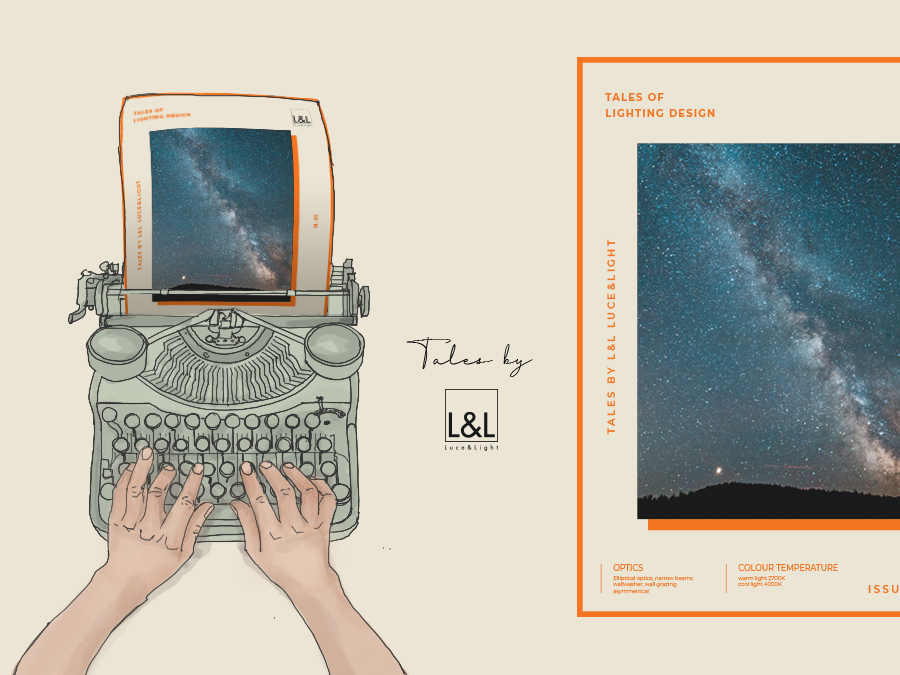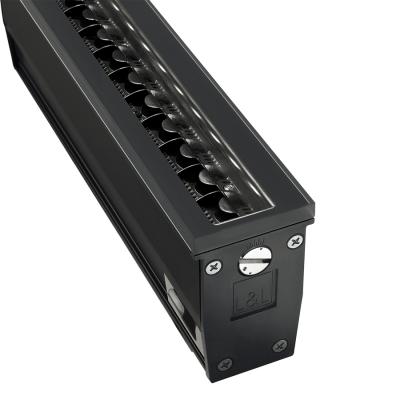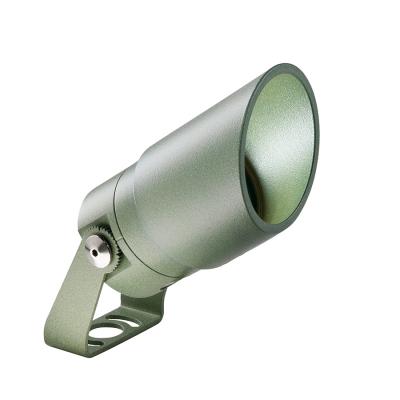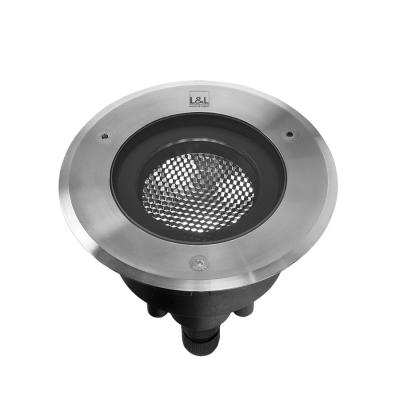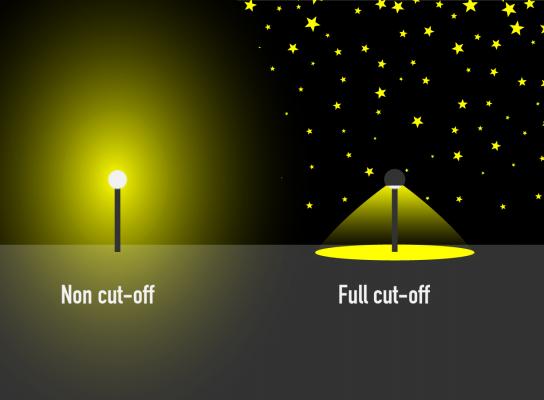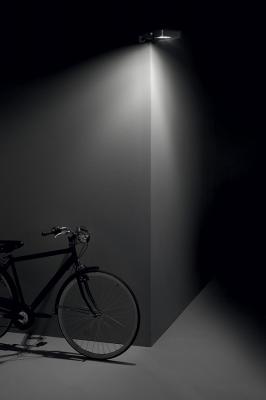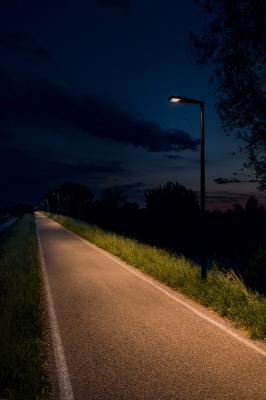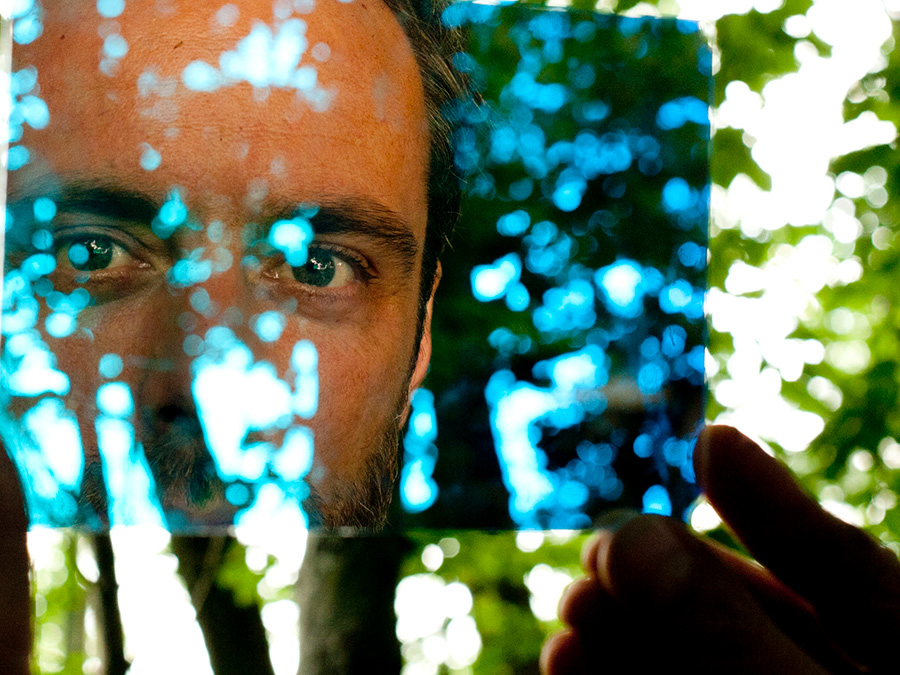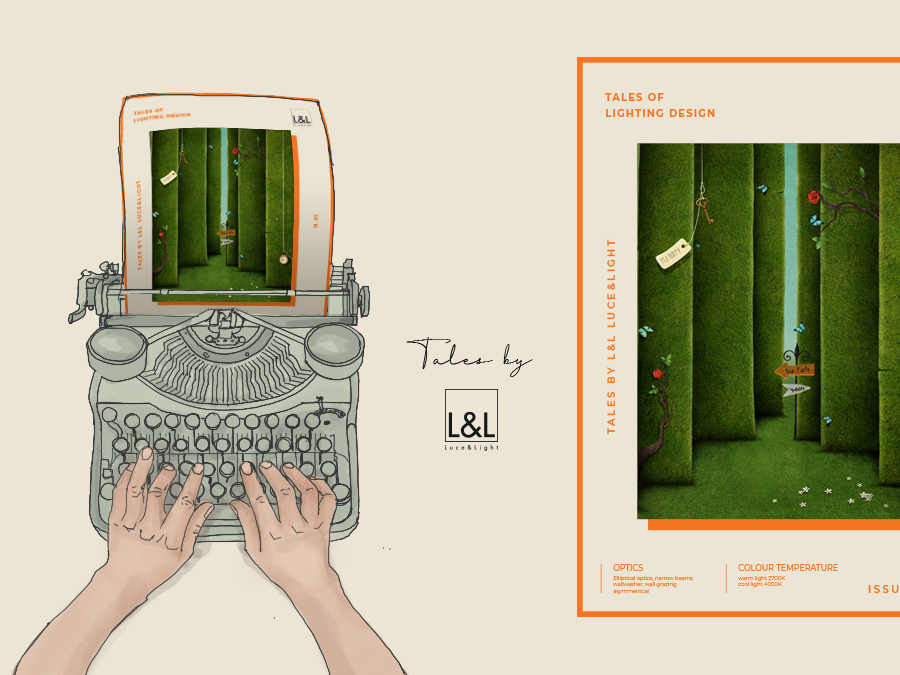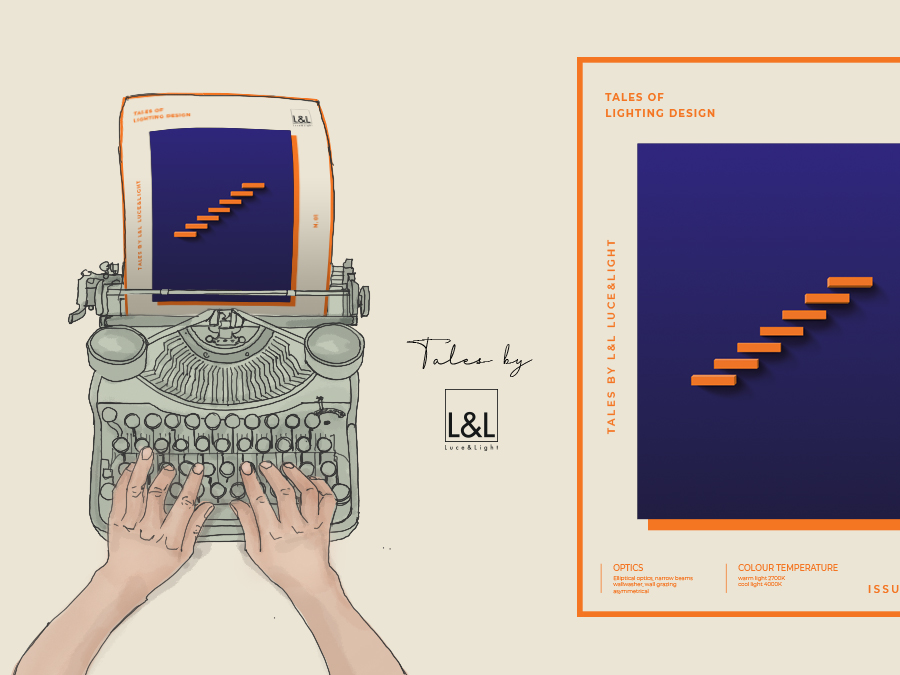Silence in court, the judge is ready to pass judgement!
The voices in the courtroom are hushed, as we wait for the judge to deliver their decision and clarify who is responsible for the crime of light pollution.
Let’s take a step back and return to the start of legal proceedings for this case, when it was entered in the register of suspects.
Face to face with light pollution – the facts
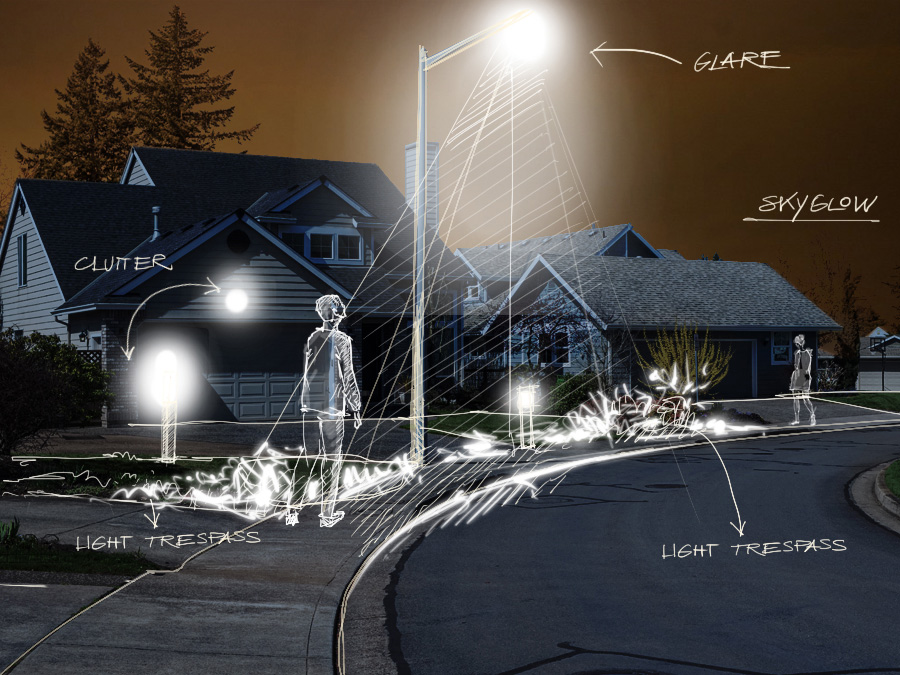
Yesterday, the subject was returning home at the end of his working day, at around 7 pm. It should be noted that, as the incident occurred in late winter, the sky was already dark.
Due to an appointment with a client, he found himself travelling a different route from usual, in an unfamiliar part of the city.
Disorientated, he looked for directions and, when he looked up to read a road sign, he suffered his first setback: glare. He was blinded by the improperly shielded light source of a lamppost.
To regain his vision, he instinctively turned his head to the opposite side of the road, where he caught a light clutter in the act: two light sources overlapped each other for no reason whatsoever – on one side an LED streetlight, on the other an old sodium wall light, and in the middle a jumble of light.
The subject was continuing cautiously on his way when he received a verbal warning from a gentleman in his sixties. The man was chatting in the garden with his wife when he felt the passer-by’s intrusive gaze. The latter, visibly embarrassed, tried to apologise, pointing to the light trespass from the lamp on the corner of the street as the cause of the incident, but he was not understood.
According to his statement, the individual, completely disheartened by now, looked up to the heavens. Your Honour, you can imagine how this gesture gave him no relief: the skyglow prevented him from admiring the sky, drowned as it was in an orange glow.
What is light pollution? The crime
Light pollution is 1
The phenomenon is made up of four components, often combined or overlapping with each other:
🔶 glare: excessive brightness that causes visual discomfort;
🔶 light clutter: bright, confusing and excessive groupings of light sources;
🔶 light trespass: light falling where it is not intended or needed;
🔶 skyglow: brightening of the night sky over inhabited areas. 2
The above definitions were drawn up by the IDA (International Dark-Sky Association), a worldwide organisation based in the United States.
The association has been investigating light pollution since 1988 and encouraging international communities to move towards more environmentally sound lighting. It carries out research, and provides data and results, aimed at preventing the crime under investigation.
Proof of the seriousness of light pollution, in this case skyglow, is presented in the study published by Science Advance in the World Atlas of Artificial Night Sky Brightness in 2016. According to this source, 83% of the world’s population and 99% of those in Europe and the United States live under light-polluted skies. Put simply, one in three people cannot see the Milky Way, including 60% of Europeans and nearly 80% of North Americans. 3
Further evidence is provided by NASA’s Earth Polychromatic Imaging Camera (EPIC). EPIC records and photographs the planet Earth from space on a daily basis, producing the city lights map shown below. We draw your attention to the obvious over-illumination affecting the most industrialised areas of the planet.
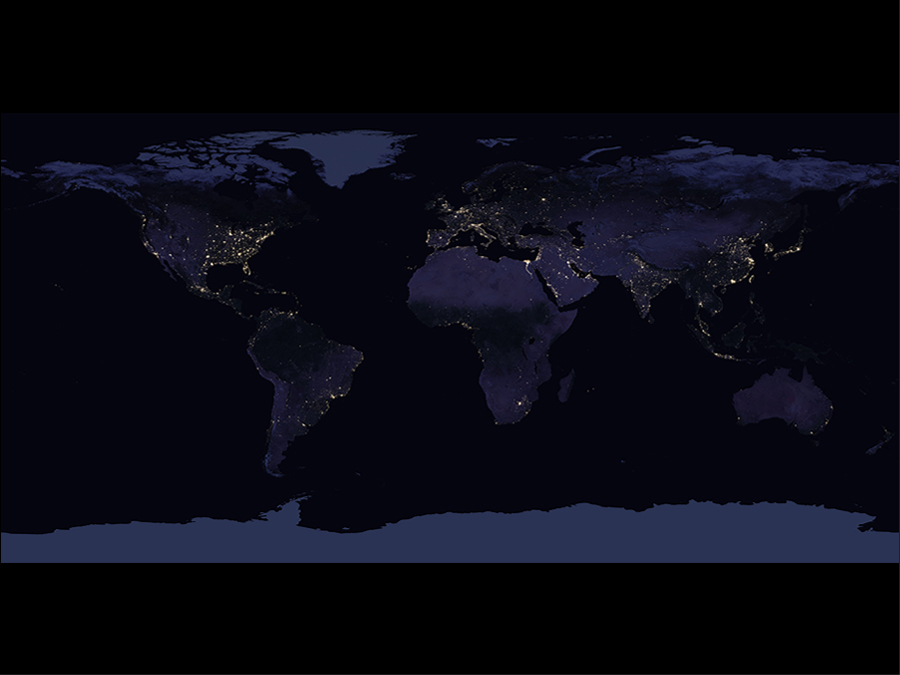
Earth at Night: Global Map 2016 (NASA Earth Observatory)
The law is not the same for everyone, everywhere – the legislation
The crime of light pollution is not subject to supranational legislation, due to the great variety of situations and needs in individual countries. It was decided to adopt guidelines that leave a wide margin of discretion to individual States, giving them the task of striking the right balance between environmental protection and the country’s needs.
It is also true that legal sources diverge at a local level, too, as is the case in Italy. Here, laws are drawn up on a regional basis.
📜 The Veneto region has shown itself to be a pioneer in this area, thanks to the presence of astronomical and astrophysical observatories on the Asiago plateau in the province of Vicenza (we’re playing at home here - Ed.). In 1997, the Veneto Region passed a law setting out “rules for the prevention of light pollution”, an example followed by other regions. 4 Two years later, the Ente Italiano di Normazione (the Italian standardisation body) issued the UNI 10819:1999 standard, updated in March 2021, which prescribes “calculation and verification methods for evaluating the upward dispersal of luminous flux from artificial light sources of lighting systems in outdoor areas”. 5
📜 In France, the ANPCEN (Association Nationale pour la Protection du Ciel et de l’Environnement Nocturnes – national association for the protection of the night sky and environment) issued an ordinance recommending the use of sources with a temperature of 2200K to discourage the use of lights with a high blue content, which contribute most to light pollution. 6
📜 These regional legislations reference the EU Green Public Procurement Criteria for Road Lighting and Traffic Signals, known as GPP, which prescribes the use of light sources with colour temperatures of 3000K or less. 7
📜 Across the Atlantic, in the United States, the Model Lighting Ordinance (MLO) was issued in 2011 by the IDA and IESNA. The MLO is intended as a guide for individual municipalities to develop regulations to control and reduce outdoor light pollution. 8
Preliminary investigations - the accused in the dock
An analysis of the crime report leads the investigation to the possible perpetrators of the crime of light pollution.
In the first instance, outdoor lighting is identified as the potential culprit. This includes lighting urban areas with an excessive number of streetlights, installing advertising or shop signs with emissions that exceed the necessary brightness threshold, and lighting the exterior of buildings and homes without reason, where and when it is not needed.
A careful examination of the events leads to extending liability to include indoor lighting. This is the case in commercial premises, such as shops and offices, where the interior lights are left on after hours without altering the output and intensity based on night-time visual calculations.
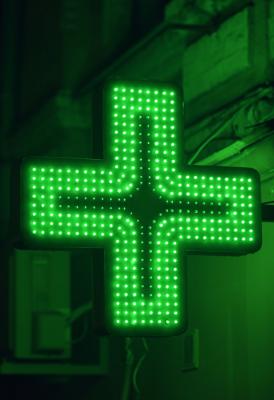
Light pollution: shop signs 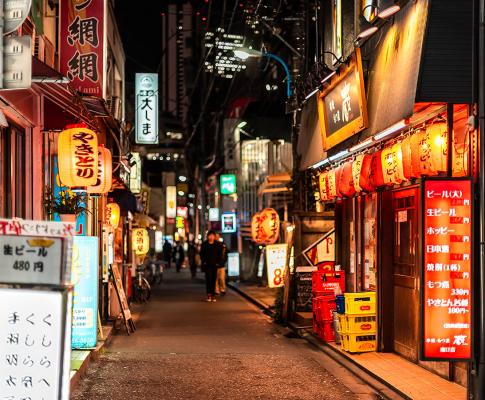
Light pollution: advertising signs 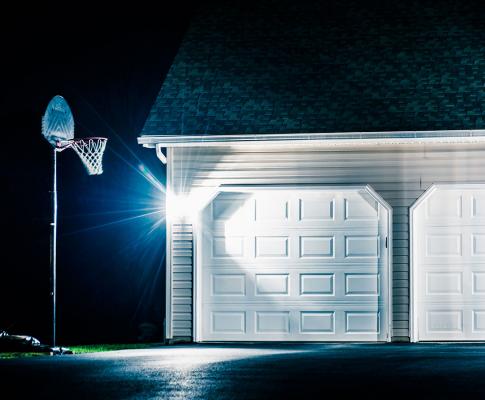
Light pollution: lighting where and when it is not needed 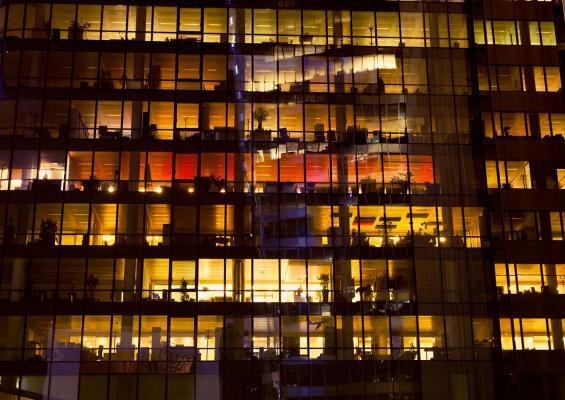
Light pollution: interior lights
In view of the above, we need to examine some scientific tests and analyses to verify the extent of the responsibility of artificial light, both indoor and outdoor, in causing light pollution.
Investigation 1 - light pollution and animals
Scientific studies show the consequences of light pollution on animal behaviour in areas ranging from courtship and migration to sense of direction and availability of food.
A few examples:
🦉 Owls use darkness to hunt and surprise their prey, while the latter use darkness to hide. This results in a hunter-prey balance based on natural darkness at night.
🦟 Fireflies need darkness to communicate and court using their luminescence. Artificial lights create confusion and prevent these beetles from finding a partner to mate with.
🐢 Turtle reproduction is affected by electric lighting, which inhibits their sense of direction. This species finds its way back to the sea after laying its eggs by following the moonlight and starlight reflected on the crests of the waves. The presence of other light sources confuses both adult and young turtles, making it difficult or even impossible for them to find their way back to the water.
🦅 Finally, these examples would not be complete without mentioning migratory birds that lose their way due to the visual stimuli of artificial lights, and risk exhaustion as a result of their extended flight times.
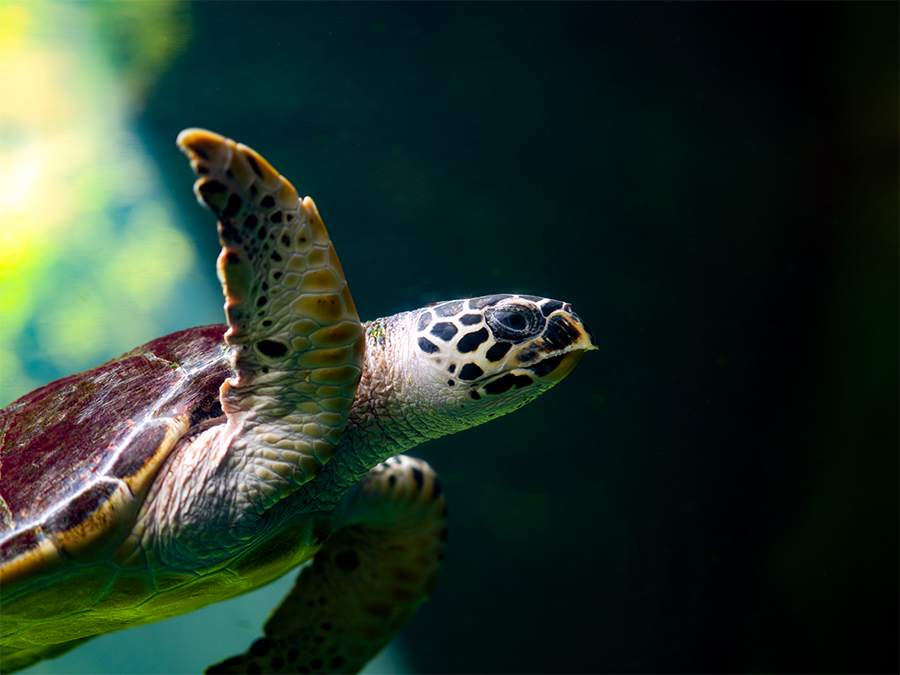
These case studies have prompted an in-depth evaluation of artificial light sources and their relationship with animals. Further studies have shown that different animal species have different susceptibilities to light emission wavelengths.
For most animals, cool tones are the most dangerous, creating the greatest disruption. In contrast, long-wavelength sources with temperatures of 3000K or less are often well tolerated or even without effect. In the case of turtles, for instance, it has been shown that they are not affected by amber-coloured light and can find their way back to the sea without difficulty, recognising the reflection of the moon on the sea. 9
It follows that the animals’ imbalances are not always determined by the presence of artificial light per se: sometimes the colour temperature is the relevant factor.
Investigation 2 - light pollution and people
Like wildlife, people also suffer the effects of light pollution, which, we should remember, is defined as any negative effect or impact that can be attributed to artificial light at night.
The advent of artificial lighting made it possible to ignore the natural rhythms of light / dark and day / night and to continue human activities beyond sunset. Exposure to short wavelength sources, especially during the evening hours, interferes with the human body and disrupts the circadian rhythm with potential health consequences, including serious illnesses such as depression, obesity and, in extreme cases, cancer.
Cool or blue light activates the brain, suggesting a state of activation as if in broad daylight, hindering melatonin production. Conversely, warm tones are unconsciously associated with the natural evening light of sunset, inducing the body to prepare for sleep.
To illustrate this information, look at the same room in cool and warm light.
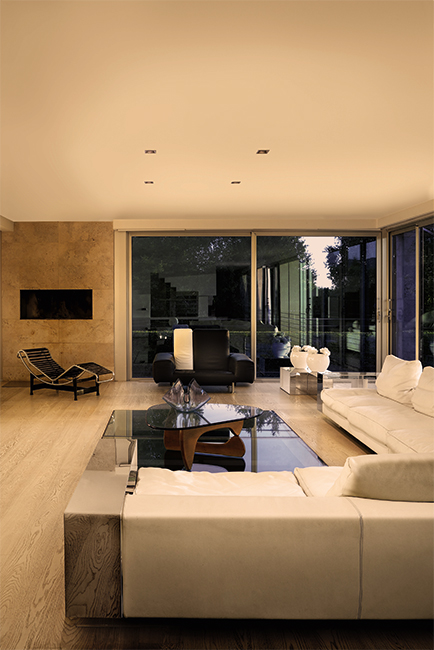
Warm light
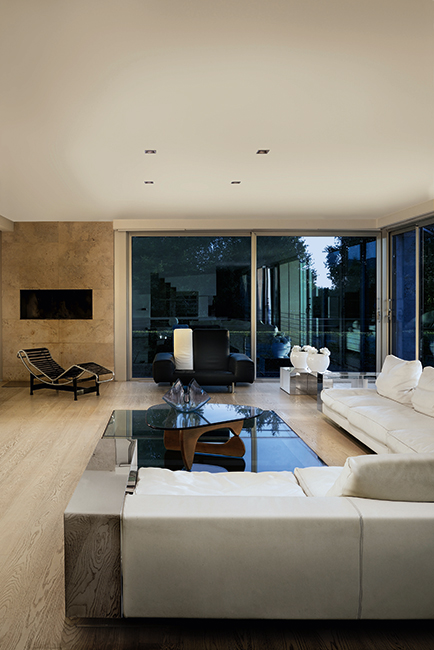
Cool light
It becomes clear that the intensity of the light also plays a part in altering people’s equilibrium. Over-illumination causes the nervous system to interpret the situation as a daytime scene, regardless of whether it is actually midday or midnight.
To appreciate the visual importance of dimming, take a look at the same room in different light intensities. In the first case, the lighting is very intense, and the living room is brightly lit: this stimulates wakefulness and encourages the occupants to maintain a high attention threshold. In the second case, the lighting is more discreet and encourages relaxation, as befits the evening hours. 10
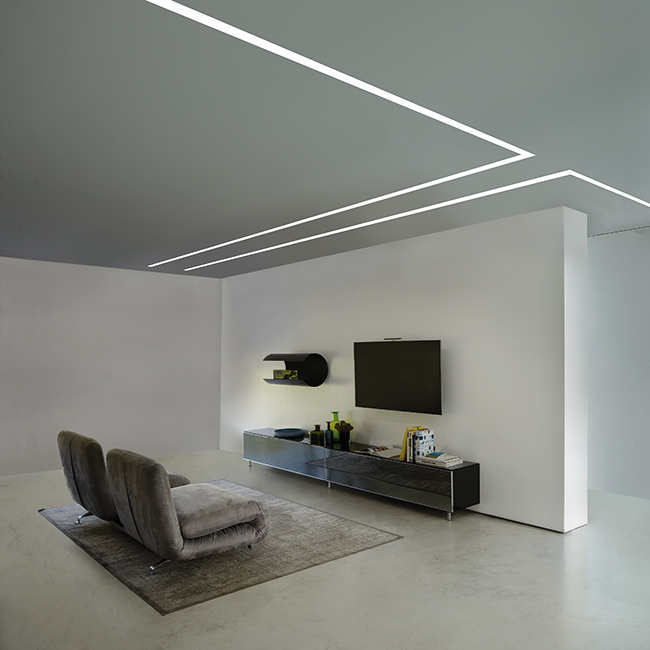
High light intensity
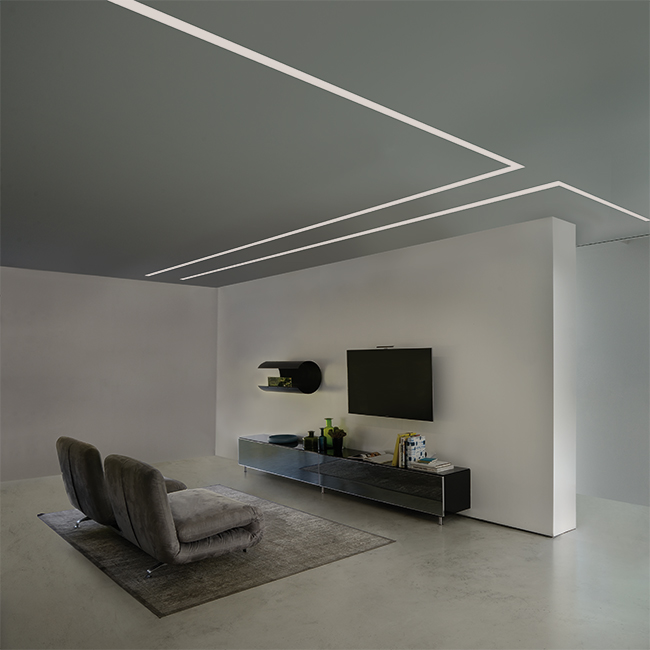
Low light intensity
It is advisable to choose not only light sources with long wavelengths and warm tones, but also dimmable lamps, so that the light intensity can be lowered when not required, respecting the human biological balance.
Investigation 3 - over-illumination and wasting public money
There is a close correlation between the phenomena that generate light pollution and wasted economic resources. Paradoxically, the availability of more powerful light sources has led municipalities to increase the number of lighting fixtures without considering the real requirements of the place and time, leading to over-illumination.
As an example of this kind of thinking, let’s look at the data on electricity consumption for lighting in public areas. The IDA reports that, in the US, 120 terawatt-hours of energy are consumed every year by outdoor lighting, mainly on streets and in car parks. That’s enough to power New York City (The City That Never Sleeps) for two years. 11
In Italy, municipalities spend 1.8 billion euros a year on energy, two thirds of which is spent on public lighting. Enough to put the country at the top of the European ranking for this expenditure. 12
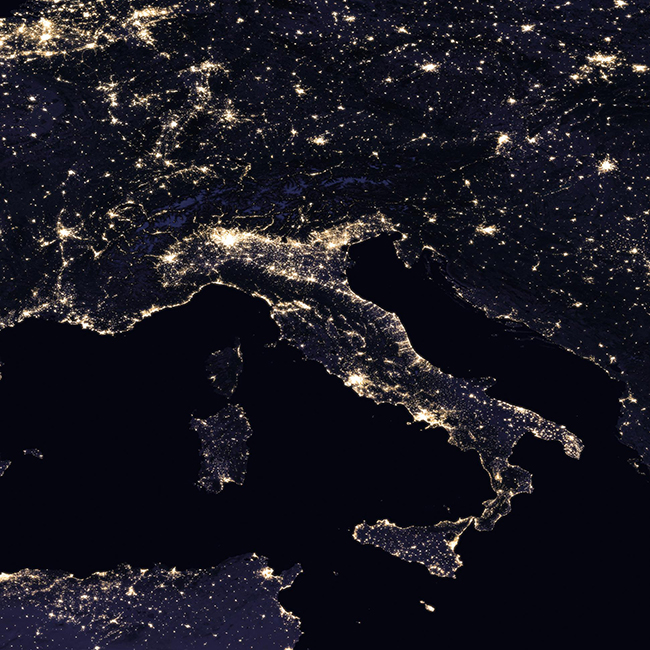
Italy, 2016 (Nasa Worldview Earthdata)
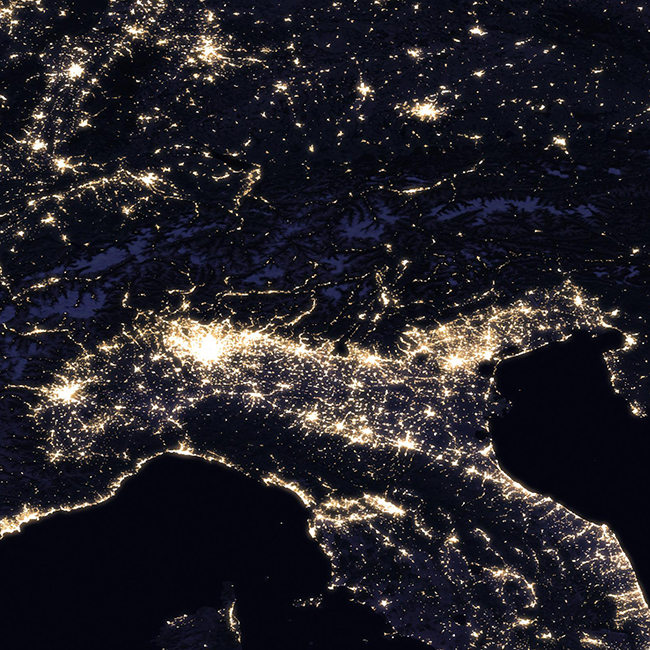
Northern Italy, 2016 (Nasa Worldview Earthdata)
Does a shopping centre car park really need to be lit at night? Is there any point in keeping all the streetlights on a country road switched on at 3 o’clock in the morning? In places like these, there is minimal human activity at night, and there is no need for blanket lighting.
Of course, it could be argued that high light levels even in isolated locations reduce the incidence of crime or the risk of traffic accidents. However, this argument has been refuted by the LANTERNS project, which looked at 62 locations in England and Wales over 14 years (2000 to 2013). Different lighting strategies were implemented: total or partial switch-off of public lighting, dimming, and replacement of traditional sources by LED fixtures.
The data collected showed that there is no correlation between a reduction in public lighting and an increase in crime or accidents. 13
The three lighting control strategies analysed in the LANTERNS project are not only the subject of research: they are sometimes explicitly required by legislation. For example, Veneto regional law requires a luminous flux reduction of more than 30% by midnight.
Dimming systems can calibrate the intensity and quantity of light emitted in a given area or at specific times of day. On this subject, it is worth mentioning virtual midnight, a dimming mode that allows the light output to be reduced at night without the need to use and install additional control electronics.
The use of presence sensors further optimises outdoor lighting, ensuring that the fixture only switches on when a vehicle or person passes. This minimises energy waste and limits the amount of light spilling into the surrounding environment.
Back to the judge – conclusions
Back in the courtroom, the judge is about to deliver their verdict.

In order to understand where responsibility lies for the crime of light pollution, three investigations were carried out. The analyses carried out show that artificial lighting is not responsible for the crime of light pollution.
Rather, it is the incorrect use of the devices through which artificial lighting is obtained that is the culprit.
Taking into consideration the subjective component that determines the selection and application of lighting equipment, the Court would like to urge everyone present to always seek the advice of a qualified lighting professional to avoid the occurrence and spread of this crime.
There is a need for responsible lighting that respects the environment while meeting the architectural and design requirements. This approach follows legislation where present.
⚖️ The first step towards responsible lighting is the choice of the fixtures’ position and orientation. A fixture’s position must take into account not only what is to be lit but also who will be in the vicinity, to prevent the light source shining directly into anyone’s eyes and to avoid glare.
Careful positioning of the fixture is the first factor in limiting upward light spill.
It goes without saying that opting for top-down lighting will minimise light spill into the environment. Where this is not possible, and the lighting design requires lighting from below, the next step is to assess the characteristics of the element or structure to be lit.
To obtain a wall-grazing effect that enhances the texture of a wall the fixture’s light emission needs to be parallel to that wall. To prevent the light from spilling into the sky it is preferable to have an element such as a cornice to contain it, keeping the light within the building’s contours.
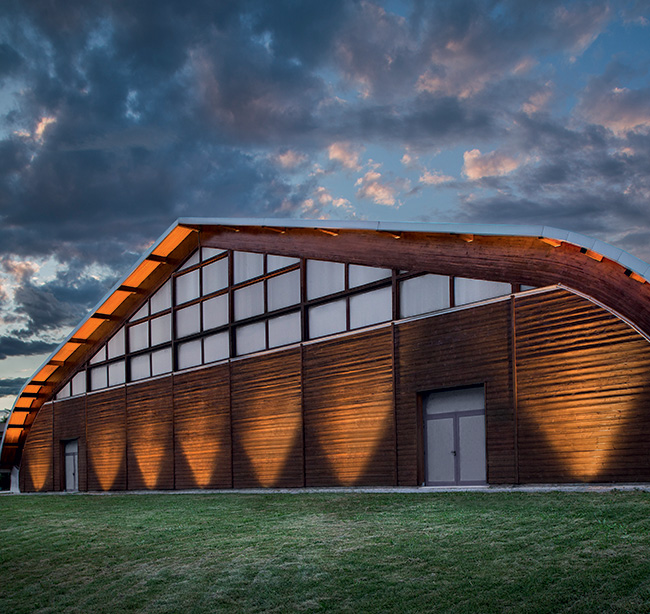
Stra 1.0, 3000K, 37W, 66°x11° Find out more about the product
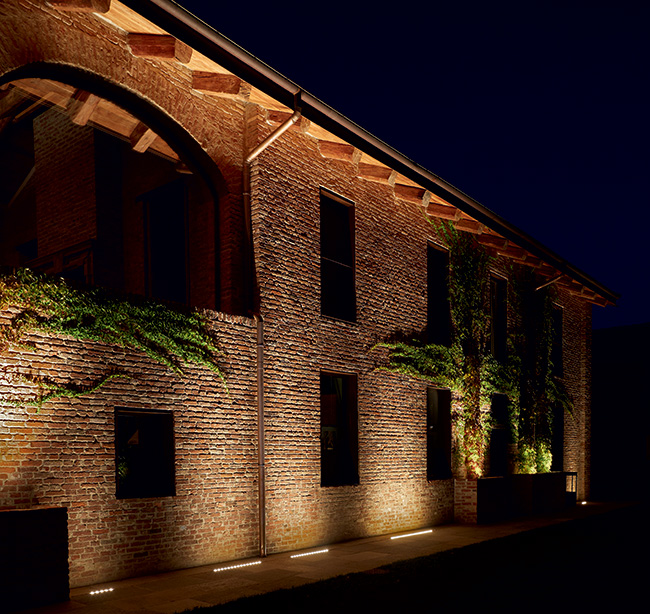
Neva 1.1, 2700K, 27W, 10°x40°, with honeycomb louvre, customized version CRI 90 Go to the project and credits
In the absence of cornices and canopies, the light emission should be directed towards the wall. asymmetrical, wall washer and adjustable optics all make it possible to direct and concentrate light on the vertical surface, avoiding light spilling unnecessarily either to the side or upwards.
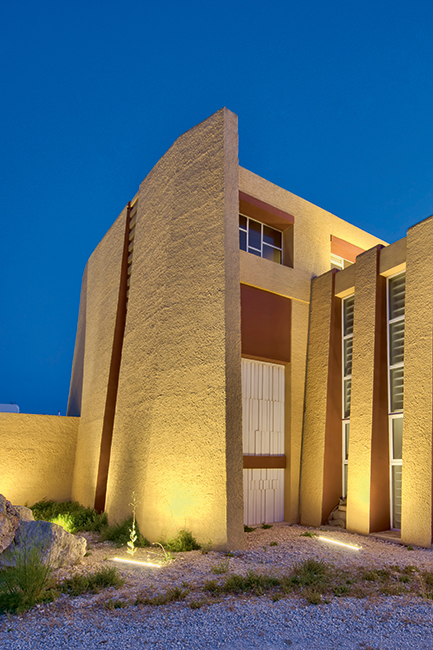
River 2.1, 2700K, 40W, wall washer Go to the project and credits
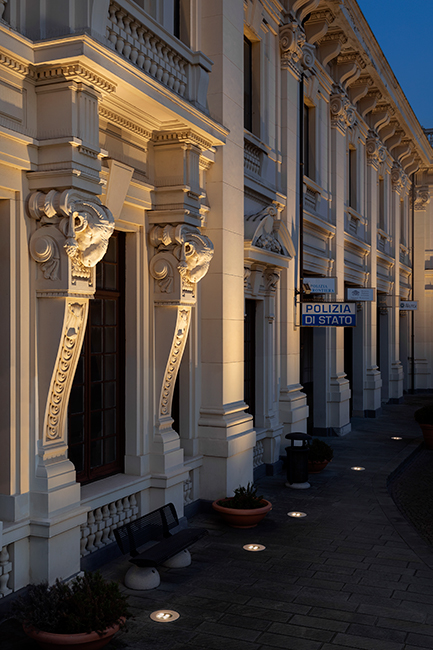
Stra 3.0, 3000K, 25W, 30° + 14°, tamper-resistant screws, customized version with trim ø330 mm Go to the project and credits
⚖️ Assessing the type of optics to use leads us to examine more closely the technical characteristics of the lighting fixtures, starting with the light source.
LED technology is frequently accused of being a harmful form of lighting because of the blue component of the light output. However, recent developments have given us both light sources with warm colour temperatures and FLEDs (Filtered LEDs) – where a different source is not possible, these use filters to exclude the blue light. This means we can have the high performance of LEDs coupled with long-wave outputs, which are healthier both outdoors and indoors. In addition to this, controlling light intensity and programming on/off lighting scenes reduces the amount emitted into the surroundings and therefore reduces skyglow.
Anti-glare accessories, in particular snoots and anti-glare shields, which direct the light beam towards the area or element to be lit, also help to reduce light spill. The main function of these elements is to prevent glare by screening the light source or “filtering” it through a honeycomb pattern, as in the case of the honeycomb louvre.
⚖️ In outdoor lighting, the characteristics of the fixture’s body are key to keeping the light below the horizon line and respecting natural darkness.
In the case of downward-pointing lighting fixtures such as bollards or pole-top luminaires, the shape of the lamp and the choice of a flat screen further help to shield the light and achieve full cut-off, that is to say a light intensity of 0 at 90° and beyond, to limit light pollution.
In urban lighting, the use of directional optics means lighting fixtures can be installed at a lower height than traditional lamps, thus limiting the spread of light into the environment.
Editor’s note: And, with that, let’s leave the courtroom that hosted this short legal thriller :)
It gave us the pretext to reflect on the thorny issues of artificial light, too often unfairly accused, and to promote a responsible use of light.
___________________
Light pollution as explained in the official IDA video:
Bibliography
- IDA, Who We Are, https://www.darksky.org/about/(27/09/2021)
- IDA, Light Pollution, https://www.darksky.org/light-pollution/ (27/09/2021)
- Science Advances, The new world atlas of artificial night sky brightness, https://advances.sciencemag.org/content/2/6/e1600377 (27/09/2021)
- Regione del Veneto, Inquinamento Luminoso, https://www.regione.veneto.it/web/ambiente-e-territorio/inquinamento-luminoso (27/09/2021)
Gazzetta Ufficiale della Repubblica Italiana, Legge Regionale 27 giugno 1997, n. 22,
https://www.gazzettaufficiale.it/atto/regioni/caricaDettaglioAtto/originario?atto.dataPubblicazioneGazzetta=1997-11-15&atto.codiceRedazionale=097R0591 (27/09/2021) - UNI, UNI 10819:2021, http://store.uni.com/catalogo/uni-10819-2021 (27/09/2021)
- ANPCEN, https://www.anpcen.fr/?id_ss_rub=127&id_actudetail=232 (27/09/2021)
- European Commission, Revision of the EU Green Public Procurement Criteria for Road Lighting and traffic signals, https://publications.jrc.ec.europa.eu/repository/handle/JRC115406 (27/09/2021)
- IDA, Model Lighting Laws & Policy, https://www.darksky.org/our-work/lighting/public-policy/model-lighting-laws-policy/ (27/09/2021)
- Ecological Society of Australia, The impacts of artificial light on marine turtles, https://www.ecolsoc.org.au/?hottopic-entry=the-impacts-of-artificial-light-on-marine-turtles (27/09/2021)
IDA, Light Pollution Effects on Wildlife and Ecosystems, https://www.darksky.org/light-pollution/wildlife/ (27/09/2021)
IDA, Fireflies Need the Dark to Talk with Light, https://www.darksky.org/fireflies-need-the-dark-to-talk-with-light/ (27/09/2021)
The Ecological Society of America, Bright lights in the big cities: migratory birds’ exposure to artificial light, https://esajournals.onlinelibrary.wiley.com/doi/abs/10.1002/fee.2029?af=R (27/09/2021) - Circadian light, Report of the council on science and public health, Light Pollution: Adverse Health Effects of Nighttime Lighting,
http://circadianlight.com/images/pdfs/newscience/American-Medical-Association-2012-Adverse-Health-Effects-of-Light-at-Night.pdf (27/09/2021) - IDA, 5 Appalling Facts about Light Pollution, https://www.darksky.org/5-appalling-facts-about-light-pollution/ (27/09/2021)
- Lifegate, Inquinamento luminoso, cause e conseguenze, https://www.lifegate.it/inquinamento-luminoso-cause-e-conseguenze (27/09/2021)
- Journal of Epidemiology and Community Health, The effect of reduced street lighting on road casualties and crime in England and Wales: controlled interrupted time series analysis, https://jech.bmj.com/content/69/11/1118 (27/09/2021)

